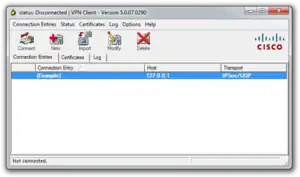Cisco Systems VPN Client
Cisco Systems VPN Client is a software application for connecting to virtual private networks based on Internet Key Exchange version 1.
 Cisco VPN Client on Windows 7 | |
| Developer(s) | Cisco Systems |
|---|---|
| Stable release | |
| Preview release | 4.9.01.0230 for Mac
/ July 27, 2010 |
| Operating system | Windows, Mac OS X 10.4 and 10.5, Solaris UltraSPARC, Linux (Intel)[3] |
| Size |
|
| Available in | English |
| Type | VPN software |
| License | Proprietary |
| Website | www |
On July 29, 2011, Cisco announced the end of life of the product. No further product updates were released after July 30, 2012, and support ceased on July 29, 2014.[4] The Support page with documentation links was taken down on July 30, 2016, replaced with an Obsolete Status Notification.[5]
Availability and compatibility
The software is not free but is often installed on university and business computers in accordance with a site-license. As with most corporate licenses, administrators are allowed to freely distribute the software to users within their network.
The open-source vpnc client can connect to most VPNs supported by the official client.
VPN Client 4.9.01.0230 beta added support for Mac OS X 10.6.[6] Stable version 4.9.01.0180 appears to lack that support; 4.9.00.0050 explicitly did not support versions of Mac OS X later than 10.5.[7]
VPN Client 5.0.07.0290 added support for 64-bit versions of Windows Vista and Windows 7.[8]
Security
The client uses profile configuration files (.pcf) that store VPN passwords either hashed with type 7, or stored as plaintext. A vulnerability has been identified,[9] and those passwords can easily be decoded using software or online services.[10] To work around these issues, network administrators are advised to use the Mutual Group Authentication feature, or use unique passwords (that aren't related to other important network passwords).[9]
See also
- Cisco ASA, the product line that replaced Cisco VPN Concentrator on the server side
References
- VPN Client release notes
- Cisco VPN Client v4.x ... Mac OS
- "VPN Client Homepage".
- https://www.cisco.com/c/en/us/products/collateral/security/vpn-client/end_of_life_c51-680819.html
- Release Notes for VPN Client, Release 4.9.01.0230 Beta for Mac OS X
- Release Notes for VPN Client, Release 4.9.00.0050 for Mac OS X, Revised: May 21, 2010, OL-11179-04
- Release Notes for Cisco VPN Client, Release 5.0.07.0290
- "Cisco Security Notice: Cisco IPsec VPN Implementation Group Password Usage Vulnerability".
- "Cisco Systems VPN Client Group Password Decoder".